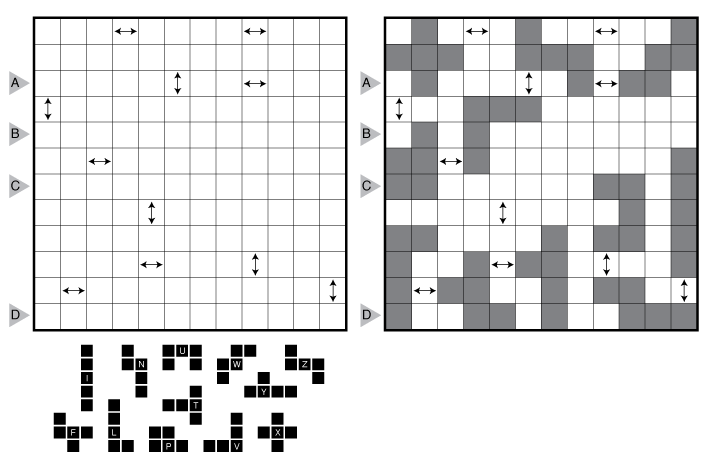Pentopia Rules and Info

Rules: Place some of the given pentominoes in the grid so that no pentominoes are in adjacent cells that share an edge or corner. Pentominoes cannot repeat in the grid; rotations and reflections of a pentomino are considered the same shape. The arrow clues indicate all the directions (up, down, left, and right) where the nearest pentominoes are located when looking from that square. (Arrow clues cannot contain pentomino shapes.)
Answer String: Enter the length in cells of each of the shape segments from left to right for the marked rows, starting at the top. Separate each row’s entry with a comma. This example has the key “112,11,221,1213”.
(Brief) History of Pentopia: Pentopia was first created by Bram de Laat for the “Hybrids – LMI March 2011” test, as a result of experimentation with combining the loop genre Myopia’s proximity style of clue with other puzzle styles. Of several variants tested, Bram found the pentomino placement genre resulted in the most interesting and different kinds of logic emerging and Pentopia was born. Removing the “all pentominoes must be used” requirement allows for greater flexibility and smaller grids for Pentopia, and this rule set is the most common when the puzzle has appeared in other competitions and puzzle sites since its invention.
History of this example: This “Back and Forth” Pentopia was created by Bryce Herdt for the Grandmaster Puzzles website.
Sources for Pentopia Puzzles: Follow this link for classic Pentopia puzzles on this website and this link for variations on Pentopia puzzles. If you are new to this puzzle type, here are our easiest Pentopia to get started on. More Pentopia puzzles can be found in Grandmaster Puzzles Quarterly Vol. 5 and on Bram’s puzzle blog.
Design rules for contributors: A Grandmaster Pentopia will have a unique solution that can be reached by logic alone. Standard grid size ranges from 10×10 to 12×12, but other sizes are possible. Symmetric clue placements, or other thematic ideas regarding the kinds of clues used, are typically expected for this style.
